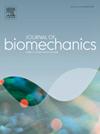Two cameras can be as good as four for markerless hand tracking during simple finger movements
IF 2.4
3区 医学
Q3 BIOPHYSICS
引用次数: 0
Abstract
Recording and quantifying hand and finger movement is essential for understanding the neuromechanical control of the hand. Typically, kinematics are collected through marker-based optoelectronic motion capture systems. However, marker-based systems are time-consuming to setup, expensive, and cumbersome, especially for finger tracking. Advances in markerless systems have potential to overcome these limitations, as demonstrated by recent applications in lower extremity biomechanics research. In this work, we aimed to integrate markerless systems for hand biomechanics research by combining open source markerless motion capture pipelines (MediaPipe and Anipose) and investigating the number of cameras required for tracking single finger flexion–extension movements. Finger movements were recorded at three different speeds (0.50, 0.75, 1 Hz) for each of the instructed fingers (index, middle, ring, little) using 4 webcams. Finger joint angles were compared when using all 4 webcams for triangulating 3D hand key points versus all 2- and 3-camera subset combinations. The number of cameras was found to affect joint angles, with differences up to 20° when using 2 or 3 cameras compared to using all 4 cameras. However, we found some 2-camera orientations had minimal differences compared to using all 4 cameras (< 4° difference for the sum of finger [metacarpal, proximal interphalangeal, and distal phalangeal] joint angles). Thus, there can be little to no benefit of adding more than 2 cameras for 3D markerless tracking of the hand during single finger flexion–extension with optimal camera placement.
求助全文
约1分钟内获得全文
求助全文
来源期刊

Journal of biomechanics
生物-工程:生物医学
CiteScore
5.10
自引率
4.20%
发文量
345
审稿时长
1 months
期刊介绍:
The Journal of Biomechanics publishes reports of original and substantial findings using the principles of mechanics to explore biological problems. Analytical, as well as experimental papers may be submitted, and the journal accepts original articles, surveys and perspective articles (usually by Editorial invitation only), book reviews and letters to the Editor. The criteria for acceptance of manuscripts include excellence, novelty, significance, clarity, conciseness and interest to the readership.
Papers published in the journal may cover a wide range of topics in biomechanics, including, but not limited to:
-Fundamental Topics - Biomechanics of the musculoskeletal, cardiovascular, and respiratory systems, mechanics of hard and soft tissues, biofluid mechanics, mechanics of prostheses and implant-tissue interfaces, mechanics of cells.
-Cardiovascular and Respiratory Biomechanics - Mechanics of blood-flow, air-flow, mechanics of the soft tissues, flow-tissue or flow-prosthesis interactions.
-Cell Biomechanics - Biomechanic analyses of cells, membranes and sub-cellular structures; the relationship of the mechanical environment to cell and tissue response.
-Dental Biomechanics - Design and analysis of dental tissues and prostheses, mechanics of chewing.
-Functional Tissue Engineering - The role of biomechanical factors in engineered tissue replacements and regenerative medicine.
-Injury Biomechanics - Mechanics of impact and trauma, dynamics of man-machine interaction.
-Molecular Biomechanics - Mechanical analyses of biomolecules.
-Orthopedic Biomechanics - Mechanics of fracture and fracture fixation, mechanics of implants and implant fixation, mechanics of bones and joints, wear of natural and artificial joints.
-Rehabilitation Biomechanics - Analyses of gait, mechanics of prosthetics and orthotics.
-Sports Biomechanics - Mechanical analyses of sports performance.
 求助内容:
求助内容: 应助结果提醒方式:
应助结果提醒方式:


